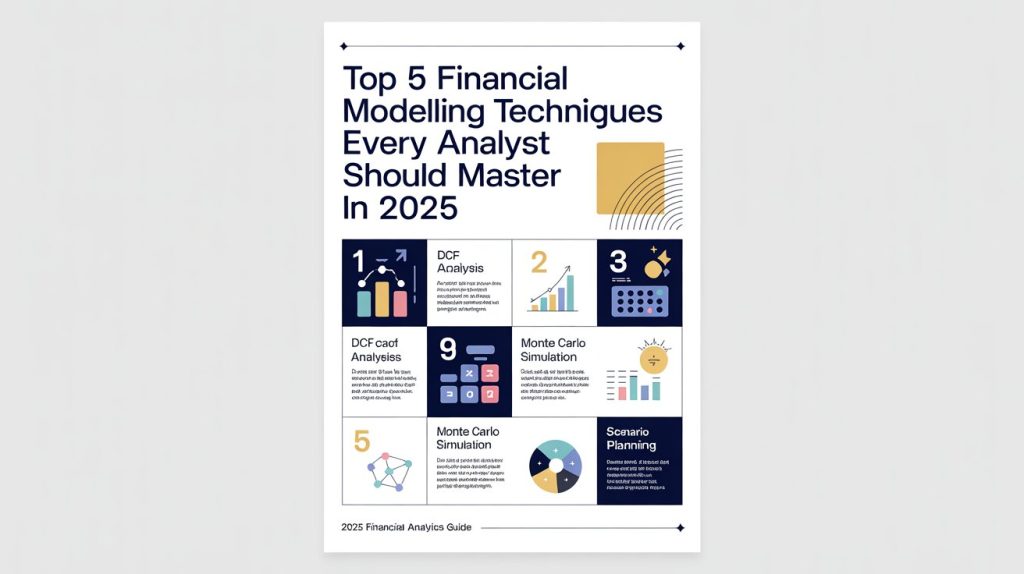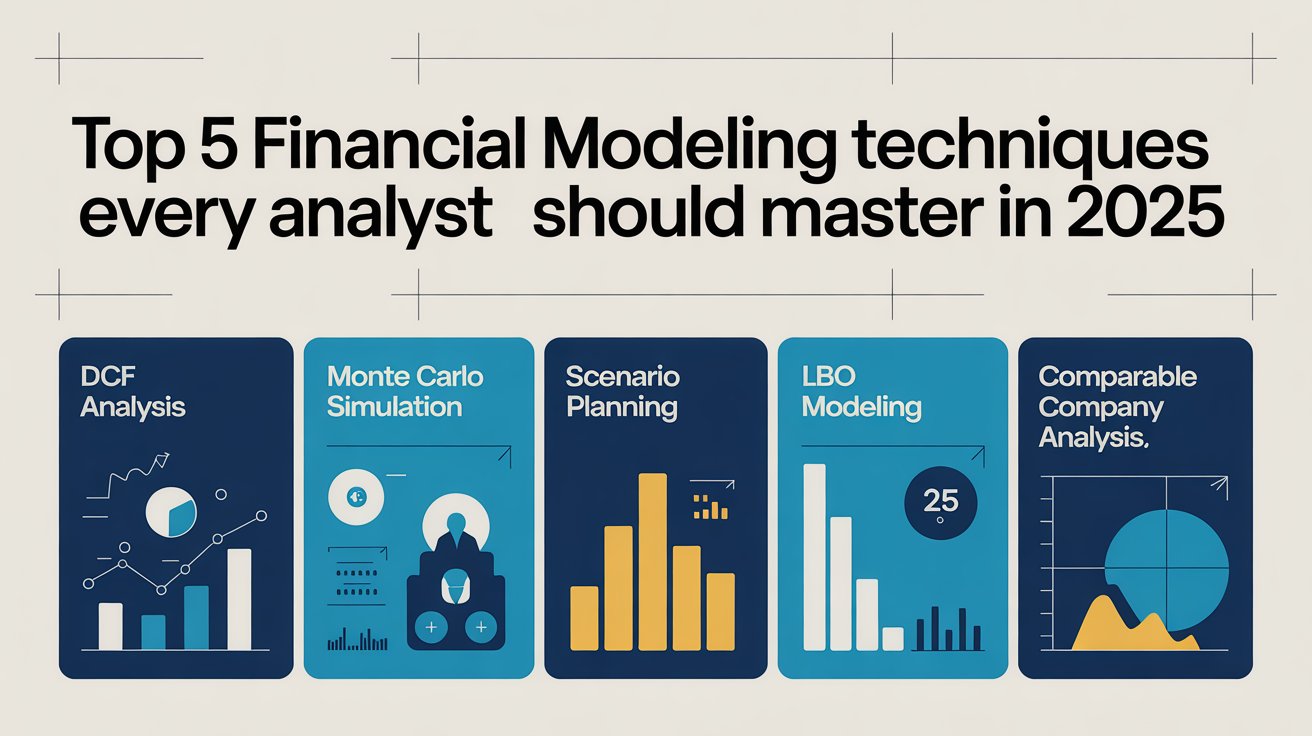Financial Modelling Techniques 2025 aren’t just a trend anymore. They’re basically the top must-have skills for any financial analyst trying to survive in today’s market. It’s not just about using formulas – it’s about translating real business decisions into numbers and stories.
Today, companies expect analysts to combine Excel modelling, business logic, and finance analytics to make sharper, data-backed decisions.
By the end of this guide, you’ll clearly understand the 5 most useful financial modelling techniques and how to use them in real company situations.
1. Three-Statement Modelling
This is the foundation of all financial modelling techniques. It connects the Income Statement, Balance Sheet, and Cash Flow Statement into one integrated framework.
By linking all three, analysts can project a company’s future performance – estimating revenues, profits, and cash flows – and test how small changes (like higher costs or lower sales) affect overall results.
This model is widely used by investment bankers, corporate finance teams, and equity researchers to understand the complete financial health of a company.
Suppose you’re analyzing Tata Motors for FY2025. You project revenue growth at 12%, with a net profit margin of 7%. The model will automatically calculate resulting operating profits, net Income and update the balance sheet accordingly– reflecting higher retained earnings and cash balances. It also adjusts debt repayment capacity – say, ₹2,000 crore of long-term debt can now be cleared without affecting liquidity.
This gives investors a clear view of whether Tata Motors can fund EV expansion from internal profits or needs external borrowing.
Pro Tip: Always cross-link your depreciation and working capital schedules – they’re the most common cause of model imbalance.
2. Financial Feasibility Studies
Before a company invests in a new project, expansion, or product line, it first checks whether the idea is financially viable.
That’s what a feasibility model does – it tests if expected returns justify the investment and if the project will generate steady cash flows.
These studies are commonly used in infrastructure, energy, and manufacturing sectors to estimate costs, payback period, and profitability.
Suppose you’re evaluating a new solar plant project by Tata Power costing ₹500 crore. Using feasibility modelling, you estimate expected revenue, operating cost, and payback period. Say, the model shows a project IRR of 14% and a payback of 7 years, meaning the investment is financially sound and manageable.
Pro Tips:
- Focus on NPV (Net Present Value) and IRR (Internal Rate of Return) for decision-making.
- Include risk factors like inflation, interest rates, and input cost changes.
- Always test the project under both optimistic and conservative assumptions.
3. Accretion Dilution Model
When one company acquires another, analysts need to know: Will this deal increase or decrease the acquirer’s earnings per share (EPS)?
That’s exactly what the Accretion-Dilution Model explains.
This model checks how the acquisition impacts the buyer’s profits, cash flows, and shareholder value. If the EPS rises after the merger, the deal is accretive; if it falls, it’s dilutive.
It helps finance professionals decide whether an acquisition adds long-term value or weakens financial performance.
Recently, Tata Motors acquired the European commercial vehicle company Iveco. Using a merger model, an analyst can assess the impact of this acquisition on Tata Motors’ expected earnings per share (EPS) — both in the near term and over the long run.
If Tata Motors’ expected EPS for the next year, say ₹52 per share without the acquisition, is projected to increase to ₹60 per share after the acquisition, the deal is considered accretive for shareholders.
However, if the EPS declines to ₹48 per share post-acquisition, it is termed a dilutive acquisition
This helps management decide whether the merger adds true value or just adds size without profitability.
Pro Tips:
- Focus on EPS impact – that’s what investors track.
- Account for integration costs, synergy gains, and goodwill adjustments.
- Run sensitivity tests for multiple exchange ratio scenarios.
4. Leveraged Buyout (LBO) Modelling
The LBO model is used to evaluate how much debt (loan) a company or investor can take to acquire another business, while still earning a profit.
It’s a key part of private equity, investment banking, and corporate M&A.
Analysts use it to test how returns change when financing comes from a mix of debt and equity.
This helps investors understand whether using leverage (borrowed funds) improves or hurts profitability and risk levels.
Suppose a private equity firm plans to acquire SpiceJet. Using an LBO model, you test a 60% debt / 40% equity structure.
The model projects cash flows, debt repayments, and investor returns. If the LBO model indicates a strong internal rate of return (IRR) — typically around 20–25% — while maintaining debt at manageable levels, it demonstrates that the deal is financially viable and capable of delivering attractive returns to investors.
Pro Tips:
- Maintain a healthy Debt-to-Equity ratio (not over 2:1 for Indian firms).
- Test the model under rising interest rate scenarios.
- Focus on cash flow stability, not short-term gain.
5. HAM (Hybrid Annuity Model) Modelling
This technique is commonly used in public infrastructure and PPP (Public-Private Partnership) projects.
HAM modelling helps bidders or contractors decide the right bid price for a project and check whether it will deliver acceptable returns.
Under this model, both the government and the private company share risks and rewards.
It includes calculations of annuity payments, cost estimates, inflation, and interest rates to evaluate long-term project viability.
Let’s say, if Larsen & Toubro (L&T) bids for an NHAI highway project worth ₹1,000 crore under HAM:
- The government pays 40% (₹400 crore) during construction.
- The remaining 60% (₹600 crore) is recovered via annuities over 15 years.
Your model forecasts annual annuity receipts of ₹55 crore and maintenance expenses of ₹15 crore, leaving a net return of ₹40 crore/year.
The IRR works out to 13.5%, making it a stable, low-risk infrastructure investment.
Pro Tips:
- Include annuity inflows, inflation, and cost escalation in assumptions.
- Check compliance with NHAI financial benchmarks.
- Run stress tests for delays in construction or payment.
So, How to Master These Techniques
To become skilled in these financial modelling techniques in 2025, focus on practical learning:
Here’s how students and aspiring analysts can get really good at it:
- Start with Excel modelling – link statements, automate formulas, and test different cases.
- Learn to interpret numbers – not just calculate them.
- Build practice models on real company data to improve your finance analytics confidence.
- Always include error checks like balance sheet balancing, consistency tests, and IRR validations.
- Keep clear documentation of assumptions and formulas — it saves time during reviews.
- And programs like The WallStreet School’s Financial Modelling & Valuation (FMV) course use real company case studies to give you practical experience, not just theory. Enrol now to get started.

Best Practices for Professional Modelling
When building models with Financial Modelling Techniques 2025, follow professional best practices to keep your models reliable, easy to review, and future-proof.
- Validate Assumptions with Historical Data:
Always check your projections against 3–5 years of past company data. This helps ensure your assumptions are grounded in reality, not just guesswork. - Use Color-Coding for Clarity:
Professional analysts follow a standard color convention – blue for inputs, black for formulas, and green for external links. It helps anyone reviewing your model understand instantly what can and cannot be changed. - Handle Circular References Carefully:
Some financial models naturally create circular links (like interest on debt or retained earnings). If you must use them, turn on Excel’s iterative calculations, document the logic, and mark them clearly for reviewers.
Conclusion
In 2025, Financial modelling has evolved beyond spreadsheets. With AI and automation entering finance, analysts are expected to think strategically – combining data, logic, and business understanding.
Professionals who master these 5 techniques can forecast accurately, evaluate deals smartly, and build models that guide real financial decisions.
As they say, “Financial modelling isn’t about predicting the future, it’s about preparing for it.”
People Also Asked:-
- What are financial modelling techniques?
Methods like three-statement models, feasibility studies, Accretion Dilution, LBO, and HAM help forecast business outcomes and guide smarter financial decisions. - What are the five techniques of financial statement analysis?
Three-statement modelling, financial feasibility, Aggression Dilution, LBO, and HAM are commonly used to analyze financial performance and project impacts. - Which financial modelling is best?
Three-statement and DCF-based models are most effective for valuing companies and making strategic business decisions. - Which tool is most commonly used for financial modelling?
Microsoft Excel is the top choice, often combined with AI tools for faster, accurate forecasting and scenario testing. - What is the highest salary in financial modelling?
Skilled analysts in India can earn up to ₹25–30 lakhs per year in top banks, consulting firms, or corporate finance roles. - Is DCF part of financial modelling?
Yes. DCF (Discounted Cash Flow) analysis is used to estimate a company’s true valuation using projected future cash flows.



